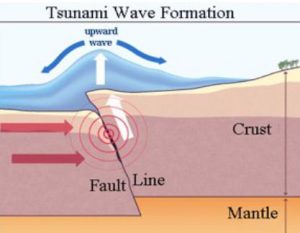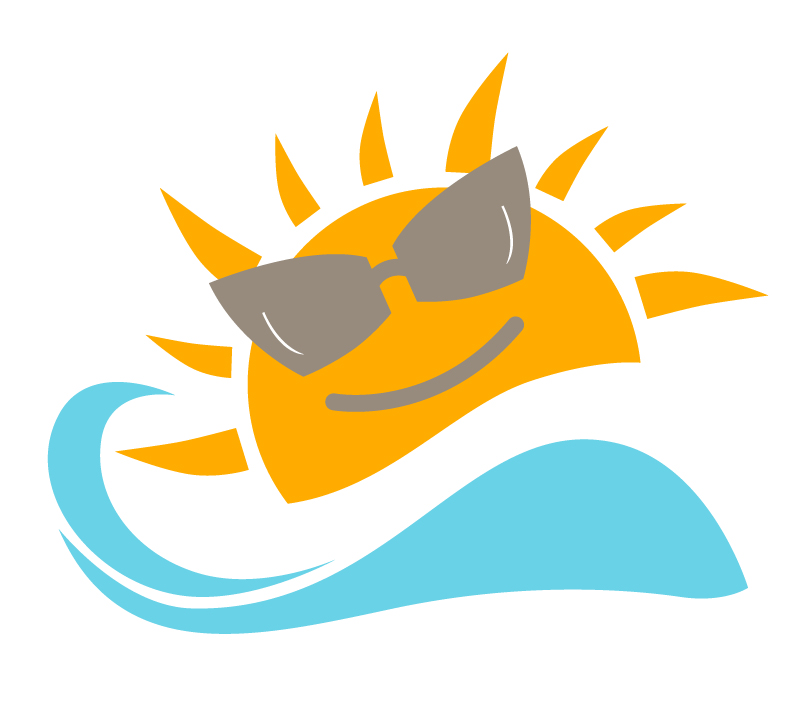By Terry Sovil from the March 2017 Edition
Tsumami is a word that originated in Japan from the late 19th century meaning tsu ‘harbor’ + nami ‘wave’ (harbor wave). It is a series of ocean waves caused by the same shift in tectonic plates that we learned about in previous articles on Earthquakes and Volcanoes. A sudden displacement in the ground from an earthquake, landslide or volcano can trigger a tsunami.
(harbor wave). It is a series of ocean waves caused by the same shift in tectonic plates that we learned about in previous articles on Earthquakes and Volcanoes. A sudden displacement in the ground from an earthquake, landslide or volcano can trigger a tsunami.
Mariners know the safest place to be in a tsunami is out on the open ocean over very deep water. In water greater than 600 feet / 183 meters in depth, a tsunami wave may be only a few inches / centimeters high and rarely over 3 feet / 1 meter high. It will pass under a boat very quickly because the wave crests come spread over time and traveling at speeds of 500 miles / 805 km per hour!
 Tsunamis travel approximately 475 mph / in 15,000 feet of water. In 100 feet of water, the velocity drops to about 40 mph as the wave grows in height. If a tsunami originated near the central Aleutian Islands (Alaska), it could reach Hawaii in about 4 hours and California in about 6! If it originated in Portugal, it could reach North Carolina in about 8.5 hours.
Tsunamis travel approximately 475 mph / in 15,000 feet of water. In 100 feet of water, the velocity drops to about 40 mph as the wave grows in height. If a tsunami originated near the central Aleutian Islands (Alaska), it could reach Hawaii in about 4 hours and California in about 6! If it originated in Portugal, it could reach North Carolina in about 8.5 hours.

Depending on the depths of water near shore, it may come ashore gently or as a fast-moving wall of water several meters high. As a tsunami moves into shallow water, the wave height can increase over 10 times. The height of the wave will vary along a coast. The wave can be amplified by shoreline and sea floor features. A large one may flood low-lying coastal land over a mile from the coast.
Like volcanoes and earthquakes, a tsunami can’t be prevented but monitoring points around the world make us aware of a potential volcano or earthquake and we can be made aware of a possible tsunami following a natural disaster. In the USA, NOAA (National Oceanic and Atmospheric Administration) has primary duties for warnings, observation and research. Net-works of monitoring can quickly sound an alarm for a possible tsunami.

Tsunamis are NOT tidal waves. Tidal waves are caused by the forces of the moon, sun and planets upon the tides, as well as the wind as it moves over the water. With typical waves, water
Tsunamis are NOT tidal waves. Tidal waves are caused by the forces of the moon, sun and planets upon the tides, as well as the wind as it moves over the water. With typical waves, water reason to move away from the beach! Tsunamis may be accompanied by loud, booming noises.
Statistically, there are about 2 tsunamis per year throughout the world. These are usually a ‘slip strike’ or horizontal motion earthquake that causes the tsunami and 10-15% of the dam-age. These inflict damage near the source or origin, of the event (volcano or earthquake). About every 15 years there is a destructive ocean wide tsunami.
OK. So what about Manzanillo, Colima and Mexico’s Pacific Coast? Historical and recorded data indicate the Pacific coast of Mexico has had destructive tsunamis over at least the past 500 years. Also affected by hurricanes, and the huge 1985 Mexico earthquake which generated tsunamis that affected Ixtapa–Zihuatanejo and Michoacán.
The following link is to Geo Science World, Seismological Research Letters, Updated Tsunami Catalog for the Jalisco‐Colima Coast, Mexico, using data from historical archives: http://srl.geoscienceworld.org/content/early/2016/12/02/0220160133
The charts and maps are from geoscienceworld.org.
This group extensively researched online catalogs, newspapers, incidents recorded to create a new look at the activity near us over the years. A visit to their site is a great look at the history. As we noted before in the Earthquakes article, our area is a complex setting of tectonic plates. They crafted a revision of tsunamigenic earthquakes over the years to document our area.
This includes the occurrence of 21 events; 2 earthquakes documented for the first time (in 1563 and 1816) for the Jalisco‐Colima coast, and 8 large or medium intensity tsunamis also first reported (1816, 1818, 1900 [two tsunamis], 1911, 1933 [two tsunamis], and 1941) through documentary evidence.
Download the full edition or view it online
—
Terry is a founding partner and scuba instructor for Aquatic Sports and Adventures (Deportes y Aventuras Acuáticas) in Manzanillo. A PADI (Professional Association of Dive Instructors) Master Instructor in his 36th year as a PADI Professional. He also holds 15 Specialty Instructor Course ratings. Terry held a US Coast Guard 50-Ton Masters (Captain’s) License. In his past corporate life, he worked in computers from 1973 to 2005 from a computer operator to a project manager for companies including GE Capital Fleet Services and Target. From 2005 to 2008, he developed and oversaw delivery of training to Target’s Loss Prevention (Asset Protection) employees on the West Coast, USA. He led a network of 80+ instructors, evaluated training, performed needs assessments and gathered feedback on the delivery of training, conducted training in Crisis Leadership and Non-Violent Crisis Intervention to Target executives. Independently, he has taught hundreds of hours of skills-based training in American Red Cross CPR, First Aid, SCUBA and sailing and managed a staff of Project Managers at LogicBay in the production of multi-media training and web sites in a fast-paced environment of artists, instructional designers, writers and developers, creating a variety of interactive training and support products for Fortune 1000 companies.



